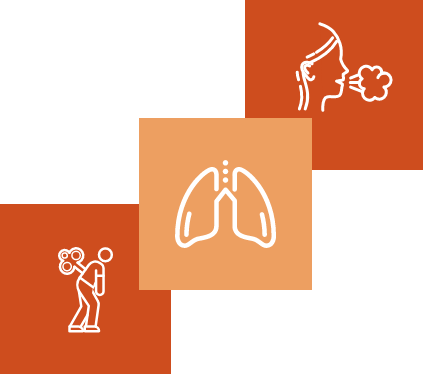
Autoimmune pulmonary alveolar proteinosis, or aPAP, is a rare lung disease without an approved pharmacologic treatment.
The IMPALA-2 clinical trial is investigating molgramostim nebulizer solution (molgramostim) for the potential treatment of aPAP.
Read more about the clinical trial and aPAP below.
About autoimmune pulmonary alveolar proteinosis (aPAP)
Autoimmune pulmonary alveolar proteinosis (aPAP) is a rare lung disease that belongs to a family of distinct rare lung diseases collectively known as pulmonary alveolar proteinosis (PAP). Autoimmune Pulmonary Alveolar Proteinosis represents about 90% of all patients with PAP. While aPAP can affect people of any age, race or sex, onset occurs most frequently in people between the ages of 30 and 40.1
PAP is characterized by the build-up of surfactant in the alveoli, or air sacs, of the lungs. The surfactant consists of proteins and lipids and is an important physiological substance that lines the inside of the alveoli to prevent the lungs from collapsing. The lungs continuously produce new active surfactant. In a healthy lung, the surfactant is cleared by immune cells called alveolar macrophages. However, in lungs of patients with aPAP, the macrophages fail to clear the surfactant from the alveoli, leading to gradual accumulation of surfactant in the alveoli. The root cause of aPAP is an autoimmune response against GM-CSF, a naturally occurring protein in the body. Pulmonary macrophages need to be stimulated by GM-CSF to function properly, but in aPAP, GM-CSF is neutralized by antibodies against GM-CSF, rendering the macrophages unable to perform their tasks, including the clearance of surfactant from the alveoli.1
In aPAP, the feeling of having trouble breathing is the most common symptom. Most people who have aPAP experience it slowly over time. People with aPAP can also experience the following symptoms:
- Chronic cough
- Feeling run down, or fatigue
- Sputum production
- Reduced ability to exercise
- Episodes of fever

Each person’s experience with aPAP can be different and at any time a person with aPAP may have their symptoms go away, only to come back later.1
The current standard of care for aPAP is a procedure called Whole Lung Lavage (WLL), which entails washing out the lungs with saline, one lung at a time, under general anesthesia. WLL is an invasive and inconvenient procedure that is performed by highly experienced physicians at specialist sites and necessitates hospitalization and admission to intensive care afterwards. In many patients, WLL may only provide temporary symptomatic relief. Once the lungs refill with surfactant, the WLL procedure needs to be repeated.
As there are no approved pharmacologic treatments available for aPAP, there is a high need for a convenient and efficacious medicinal treatment.
Read more about our aPAP clinical trial below.
References
- Towe C., Trapnell B. Pulmonary Alveolar Proteinosis. National Organization for Rare Disorders. Accessed September 8, 2021. https://rarediseases.org/rare-diseases/pulmonary-alveolar-proteinosis/